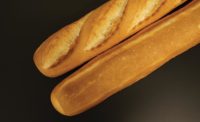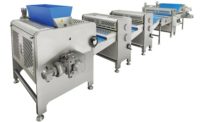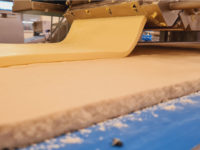Ease of cleaning, maintenance and access, as well as the ability to produce a wider variety of items, are among the top desires of companies looking to purchase dough laminators and sheeters for production of snack foods and baked goods.
Design details
Customers of Koenig Bakery Systems, Ashland, VA, are most interested in more hygienic design and the ability to produce a greater variety of snack and bakery items, says Richard Breeswine, president and CEO.
In terms of design, customers are concerned about flour, dust and waste dough getting stuck in machines, causing wear and tear, and potentially stopping production. Other hygienic aspects, such as allergens like egg and nuts, as well as increased staff safety, are also on their minds, says Breeswine.
While dough sheeting lines are often used for pastries and breads, Koenig customers also produce buns and rolls, brioche, specialty breads and even gluten-free challah or Hispanic products. “There is hardly any product that cannot be produced on a dough sheeting line,” Breeswine says. “The lines are so modular today, they can be adapted to different kinds of dough. The product changeover is easy and fast.”
Eric Riggle, president, Rademaker, USA, Hudson, OH, says his customers want machines that are easier to clean and maintain. “They also want a machine they can run for longer periods of time between planned shutdowns,” he says. “We’re seeing higher-capacity lamination lines running—we delivered a pizza line doing more than 22,000 pounds of product per hour.”
Customers are also using dough laminators for tortillas and artisan bread lines, Riggle says. “When the finished product is being used by a customer, it doesn’t break, it gives the product greater strength,” he says. “The customer has the ability to control the internal structure, getting greater volume in the process.”
Ease of access to food-contact areas and easily removable box covers for maintenance operations are among the requests of major biscuit manufacturers that use equipment from Spooner Vicars, part of Middleby Bakery Group, Plano, TX. “They want to clean the machine much more quickly, and they want simpler equipment with standardized labels and scrapers,” says Gerard Nelson, sales director. “They want simple control interfaces and quick-change parts. If you look at a laminator line, there are a lot of parts that need changing, like scraper blades and belts.”
James Cummings, president, Tromp Group USA, Dacula, GA, says advances in sheeting and laminating technology has provided the ability to cut and stack in combination with recipe software, which allows the customer to change the final dough block or final sheet width easily while loading a new recipe.
Laminating and sheeting has become more widely accepted for producing specialty breads, because the idea that a dough ball is needed to make bread is no longer an assumption. “Laminating can provide the grain, and sheeting products essentially removes the dough ball step and goes right to molding,” Cummings says. “This also allows for a wide variety of grain structures.”
Pizza is also more accepted with the advent of stress-free sheeting that’s combined, when needed, with laminating. “Sheeting lines are able to produce a lot more varieties of pizza than, say, just a press line,” says Cummings.
Customers of Erika Record Baking Equipment, Clifton, NJ, have a strong interest in a tabletop sheeter as a compact and affordable solution, as well as production lines for churning out empanadas and filled pastry products, says Jon Cabral, marketing and public relations.
Updated features
Spooner Vicars combined its customers’ requests for simpler design and ease of access with its own desires to reduce the number of components, ease of assembly and disassembly, and reduced testing and installation time to create the new A-PEX 400 laminator and sheeter, which produces crackers and hard biscuits.
The main goals were to improve access, maintenance, ease of cleaning and overall visibility so the operator can see what’s happening at any one time, Nelson says. “You have to lay products down so the edge of the sheet is absolutely vertical,” he says. “They don’t overhang or undercut each other across the bandwidth. And also, lengthways it’s seven lanes—that’s quite an easy thing to specify, but mechanically quite difficult to achieve.”
Rademaker has updated its Sigma laminator with several new features not present on previous designs, most of which have to do with greater accessibility for maintenance purposes, Riggle says. These include new belt filters that lift the belt off the frame of the conveyor during the sanitation cycle.
“There’s a sanitation mode in the control logic of the system that will allow the machine to more slowly cycle and provide a quicker drying time,” says Riggle. “Everything is on standoffs to allow any material to fall through and not get trapped.” The Sigma also replaced servo loaders to eliminate the use of compressed air, cutting down on operation costs.
Erika Record has been introducing Mecnosud sheeters, which are traditional dough sheeters that include a tabletop version (SB500) and a traditional floor model with an optional cutting station (SF600). “The cutting station component can be used to help produce croissants and other products,” Cabral says. “Our solution also features folding conveyor belts that fold into an upright position when not in use.” Mecnosud is intended for small and medium-scale pastry and bread making.
Koenig has updated its Menes dough sheeting line to make it available in a more-hygienic format, called the Menes-H. “The line is in open design for convenience accessibility, and the large wire-fence doors functioning as hand guards enable higher safety for the staff operating the line,” says Breeswine. “All transfer belts can be released without tools, most of them being exchangeable. Thanks to sealed bearings, the line is washdown.”
The machine’s belt weighing unit Accurate Weight System (AWS) allows segmented, intelligent weighing of the dough sheet across the entire width, Breeswine says. “Other modules can be adjusted accordingly, which results in higher weight accuracy, optimized use of resources and shorter production cycles,” he says. “Offering weight accuracy with dough processing machines helps the customer reduce scrap dough, to save flour and ingredients and to save costs overall.”
Koenig has also introduced a new three-roll Menes dough sheet former, which can be used for different doughs. Plug-in rollers in different surface finishes allow for both solid and soft doughs, while easily removable side plates and rollers allow for easy cleaning and maintenance.
“Due to this changing system in different widths, a variable dough width is thus achieved, and the residual dough is reduced to a minimum,” says Breeswine. “With this new system, doughs with high water content, with long fermentation time as well as short fermentation time, and fine pores can be processed just as well for optimum product quality.”
RONDO, Inc., Moonachie, NJ, has introduced a MIDOS dough-banding unit and an EVO laminator line. The company also has rolled out its RONDO CS Croissant System, boasting technological advances like the RONDONet, higher-level Internet of Things software that helps remotely monitor and analyze machinery.
MIDOS, which stands for Multiple Industrial Dough System, was developed based on customer research that showed desires for stress-free dough with accurate weight control, quick cleaning, flexible feeding options and control over dough structure without use of flour or oil—for instance, producing ciabatta bread with or without holes in the dough depending on whether it was designed for sandwiches, says Brian Inglis, key account manager, industrial division.
The EVO line provides industrial-level feeding and laminating with throughput capacity of between 1,000 and 2,000 kilograms per hour, with high process reliability and gentle dough processing. The EVO offers three models: SD for soft doughs like bread, doughnuts and pizza; LD for laminated doughs like pastries and croissants; and an MP multifunctional solution for both soft and firm doughs.
The RONDO CS high-speed industrial croissant production system features a twin-turning system using servo controls that provides full range of control over croissant turning. At a combined stroke rate of 150 per minute, the system can produce 130,000 small croissants per hour. The modular components can be mixed and matched depending on the type of croissant being produced, Inglis says. Another recent addition, the mid-level Chromaster croissant machine, produces 3,000 per hour, per row.
The RONDO Net system contains standard Internet of Things features like recipe screens and operator password control, as well as more-unusual features like an event history that “helps us understand the pattern of operation, and how fast and efficient the equipment is running,” Inglis says. “The production manager can look at a bar chart or graph in the statistical analysis screens and see, for instance, that a particular guard is being opened an unusually high number of times. They can then investigate the issue and address and eliminate the problem. This, along with other engineering features, helps to increase the uptime reliability of the machine.”
Another key feature: the machine advises preventative maintenance personnel in real time, monitoring its functions and recognizing, for example, when a drive begins to run outside the accepted parameters. “It will send a message to the engineer,” Inglis says. “It asks him to check a problem with the machine. This feature can decrease the amount of unexpected down time and also reduce wear and tear on parts, thus leading to reduced maintenance costs.”






